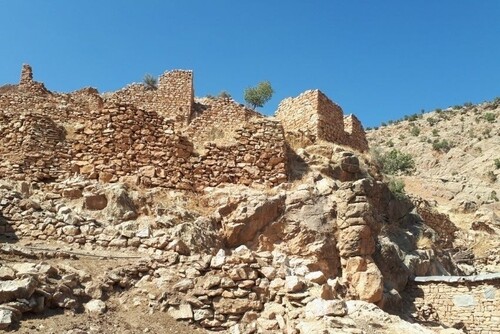Palngan Castle is located 750 meters southeast of “Palngan Village” (or in local terms, Palnan). Palngan village is located in Kurdistan province, 15 kilometers from Kamyaran. The village has a staircase architecture and a path and a branch of the Sirvan River passes through the village. Locals believe that this village has been destroyed and rebuilt several times throughout history. Historians believe that Palngan is older than all other regions of Hewraman, which is due to the presence of the historical monuments of the Tangiwar inscription and documents known as the Hawraman documents, which were found in 1905 in a cave in Tangiwar near Palngan. After Islam, when the Muslims invaded Iran, this village did not escape destruction. Even the Palngan castle which is around the village, is surrounded by Muslims. However, it is said that after the capture of the castle, they did not force the people of this area to accept Islam, because until centuries afterward the inhabitants of the area believed in their own religion, which is said to be a branch of Zoroastrianism.

Archaeologists believe the castle dates back to the seventh and eighth centuries AH. Others, however, believe that the remains of the castle date back to pre-Islamic times. Much of the castle building has been destroyed, but traces of the fire temple and the old bridge can be seen among the remains. A large stone gate has also been found whose history proves the pre-Islamic history of Palngan village and its castle. Strategically and militarily, the castle is built right on top of the mountain, which speaks of the strong defense system of the castle. All aspects of defense were considered in the construction of the castle and it was possible to monitor the entire area. The remains of the rooms in the castle show that it was also used as a shelter for the locals during enemy attacks.

According to historical accounts, Palngan Castle was the residence of the rulers of Kalhur for a while. Later, the Ardalan rulers captured the castle, and in 1168 AD, due to the unfavorable climate of Zalm Castle in Sharazur, they moved their center of power to Palngan under the leadership of Baba Ardalan. Around the 10th century AH, the castle became the headquarters of the Ardalan Emirate from Palngan to Hassan Awa in Sna (Sanandaj) with Palngan as its center in the "Shaho" mountains and near Sirwan River. In fact, the Ardalan Emirate was a ruler in the eastern part of Kurdistan during the tribal kingdoms that ruled much of the east as well as parts of southern Kurdistan for 700 years (1168-1867 AD).
In general, the Ardalan Emirate had several castles, which they used as their headquarters in different seasons of the year. Zalm Castle in winter, Mariwan Castle in autumn, Hassan Awa Castle in summer, and Palngan Castle in spring. Palngan Castle has been considered one of the most important and inaccessible castles for centuries due to its strategic location. This strategic location has given the castle different stories at different historical stages.

Palngan Castle was finally destroyed by Suleiman Khan Ardalan, who succeeded his father Khan Ahmad Khan by the order of Shasafi (The king of Safavids in Iran). Suleiman Khan destroyed not only this castle but also the four castles of the Ardalan Emirate (Zalm, Palngan, Hassan Awa, and Mariwan).
After the fall of the castle, the new city of Sna (Sanandaj) was built in 1046 AH. This decision severely reduced the defense and military power of the Ardalans. Indeed, the demolition of castles and the construction of easily controlled cities marked the beginning of the strengthening of the Safavid Empire in the region and paved the way for central Iranian rule over the Kurdish emirates. The Ardalan Emirate collapsed in 1967 after 700 years of rule. This marked the beginning of the emergence of a centralist institution in the system of power in Iran, which eventually led to the emergence of the Iranian nation-state and the political and cultural subjugation of the eastern part of Kurdistan.








